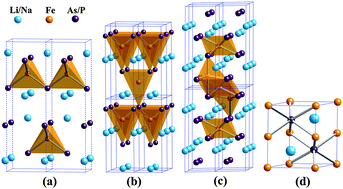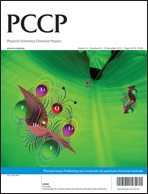High pressure structures of “111” type iron-based superconductors predicted from first-principles
Abstract
The high-pressure crystal structures of the “111” type iron-based superconductors: NaFeAs, LiFeP and LiFeAs have been systematically explored by using particle-swarm structural searches. It was found that though these iron-based superconductors are chemically similar, they adopted distinct structural phase transitions: P4/nmm → Cmcm → P![[3 with combining macron]](https://www.rsc.org/images/entities/char_0033_0304.gif) m1 for NaFeAs, P4/nmm → Cmcm → I4mm for LiFeP, and P4/nmm → P
m1 for NaFeAs, P4/nmm → Cmcm → I4mm for LiFeP, and P4/nmm → P![[3 with combining macron]](https://www.rsc.org/images/entities/char_0033_0304.gif) m1 → I4mm → P63/mmc for LiFeAs under high pressure. The high pressure orthorhombic Cmcm phase preserved the structural features of FeX4(X = As, P) tetrahedral layers present in the ambient-pressure P4/nmm structure. However, the FeX4 tetrahedrons in the Cmcm phase were clearly distorted, leading to changes in the electronic behavior around the Fermi level. Under higher pressures, the FeX4 layered structural features were no longer persistent and three-dimensional crystal structures were stabilized in other P
m1 → I4mm → P63/mmc for LiFeAs under high pressure. The high pressure orthorhombic Cmcm phase preserved the structural features of FeX4(X = As, P) tetrahedral layers present in the ambient-pressure P4/nmm structure. However, the FeX4 tetrahedrons in the Cmcm phase were clearly distorted, leading to changes in the electronic behavior around the Fermi level. Under higher pressures, the FeX4 layered structural features were no longer persistent and three-dimensional crystal structures were stabilized in other P![[3 with combining macron]](https://www.rsc.org/images/entities/char_0033_0304.gif) m1, I4mm, and P63/mmc phases, which featured FeAs5/FeAs6 hexahedron and octahedrons, FeX5 tetragonal pyramids, and FeAs6 octahedrons, respectively. Analysis of the electronic density of states suggests that most of the high pressure phases are metallic except for the tetragonal I4mm phase, which possesses a narrow band gap. This semiconducting state might relate to the tetragonal pyramid structure formed by FeX5 unit, which might be favorable for charge localization.
m1, I4mm, and P63/mmc phases, which featured FeAs5/FeAs6 hexahedron and octahedrons, FeX5 tetragonal pyramids, and FeAs6 octahedrons, respectively. Analysis of the electronic density of states suggests that most of the high pressure phases are metallic except for the tetragonal I4mm phase, which possesses a narrow band gap. This semiconducting state might relate to the tetragonal pyramid structure formed by FeX5 unit, which might be favorable for charge localization.


 Please wait while we load your content...
Please wait while we load your content...